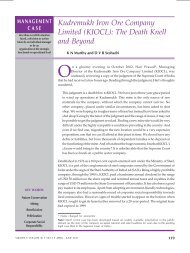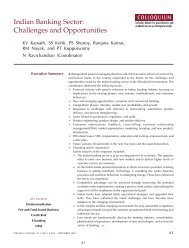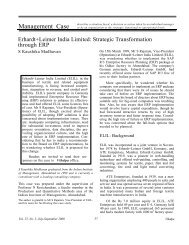Executive Summary A Study on Return on Investment of ... - Vikalpa
Executive Summary A Study on Return on Investment of ... - Vikalpa
Executive Summary A Study on Return on Investment of ... - Vikalpa
You also want an ePaper? Increase the reach of your titles
YUMPU automatically turns print PDFs into web optimized ePapers that Google loves.
A BCR <strong>of</strong> <strong>on</strong>e means that the benefits equal the costs. A<br />
BCR <strong>of</strong> two, usually written as 2:1, indicates that for each<br />
rupee spent <strong>on</strong> the programme, two rupees were returned<br />
as benefits.<br />
ROI Formula<br />
Perhaps the most appropriate formula for evaluating<br />
training investments is net programme benefits divided<br />
by cost. The ratio is usually expressed as percentage<br />
when the fracti<strong>on</strong>al values are multiplied by 100. ROI<br />
can thus be expressed as:<br />
38<br />
Net Programme Benefits<br />
ROI (%) = x 100<br />
Programme Costs<br />
The ROI value is related to the BCR by a factor <strong>of</strong> <strong>on</strong>e.<br />
This means, for example, that a BCR <strong>of</strong> 2.56 is the same<br />
as an ROI value <strong>of</strong> 156 per cent. An ROI <strong>on</strong> a training<br />
investment <strong>of</strong> 60 per cent means that an additi<strong>on</strong>al 60<br />
per cent <strong>of</strong> the costs are reported as ‘earnings’. An ROI<br />
<strong>on</strong> training investment <strong>of</strong> 150 per cent indicates that the<br />
costs have been recovered and an additi<strong>on</strong>al 1.5 multiplied<br />
by the costs is captured as ‘earnings’.<br />
Payback Period<br />
The payback period is a comm<strong>on</strong> method for evaluating<br />
capital expenditures. With this approach, the annual<br />
cash proceeds (savings) produced by the investment are<br />
equated to the original cash outlay required by the investment<br />
to arrive at some multiple <strong>of</strong> cash proceeds<br />
equal to the original investment. Measurement is usually<br />
in term <strong>of</strong> years or m<strong>on</strong>ths.<br />
Payback Period =<br />
Total <strong>Investment</strong><br />
Annual Savings<br />
DATA ANALYSIS AND RESULTS<br />
The calculati<strong>on</strong>s are based <strong>on</strong> a series <strong>on</strong> impact questi<strong>on</strong>s.<br />
Five adjustments are made to ensure that the data<br />
is credible and accurate:<br />
1) The participants who do not complete the questi<strong>on</strong>naire<br />
or provide usable data <strong>on</strong> the impact questi<strong>on</strong>s<br />
are assumed to have made no improvement.<br />
2) Extreme and unrealistic data have been omitted.<br />
3) Only annualized values are used as requested in the<br />
resp<strong>on</strong>ses.<br />
4) The values are adjusted to reflect the c<strong>on</strong>fidence level<br />
<strong>of</strong> participants.<br />
5) The values are adjusted for the amount <strong>of</strong> the improvement<br />
related directly to the programme.<br />
These five adjustments create a very credible value that<br />
is usually c<strong>on</strong>sidered to be an understatement <strong>of</strong> the<br />
benefits accrued due to the training imparted. Tables 3<br />
and 4 give the estimates <strong>of</strong> training impact from participants<br />
in the different programmes.<br />
LIMITATIONS OF THE STUDY<br />
The method chosen to isolate the impact <strong>of</strong> training is<br />
meant to obtain informati<strong>on</strong> directly from the programme<br />
participants. The effectiveness <strong>of</strong> this approach<br />
rests <strong>on</strong> the assumpti<strong>on</strong> that participants are capable <strong>of</strong><br />
determining or estimating how much <strong>of</strong> a performance<br />
improvement is related to the training programme. This<br />
is <strong>on</strong>e <strong>of</strong> the major methodological limitati<strong>on</strong>s <strong>of</strong> such<br />
studies. Err<strong>on</strong>eous, incomplete, and extreme informati<strong>on</strong><br />
could have distorted the analysis. While calculating<br />
ROI through this method, the participants should<br />
know how much <strong>of</strong> the change was caused by applying<br />
their learning from the programme.<br />
Apart from this, the following limitati<strong>on</strong>s have been figured<br />
out in the present study:<br />
1) The exact figure for cost <strong>of</strong> participants’ time was not<br />
available. Hence there is a possibility that the estimati<strong>on</strong>s<br />
made are not accurate.<br />
2) Suitable resp<strong>on</strong>ses from all the participants were not<br />
available. This means that the effectiveness <strong>of</strong> both<br />
training programmes taken into c<strong>on</strong>siderati<strong>on</strong> has<br />
been an extrapolati<strong>on</strong> <strong>of</strong> the resp<strong>on</strong>ses, which were<br />
made available. The assumpti<strong>on</strong> here is that similar<br />
benefits would have accrued from the participants<br />
who did not make their resp<strong>on</strong>se available.<br />
3) There was no possibility <strong>of</strong> even experimenting with<br />
the c<strong>on</strong>trol groups since the project commenced posttraining.<br />
4) The participants <strong>of</strong> both the programmes were posted<br />
all over the country, making distance a barrier for<br />
c<strong>on</strong>ducting in-depth interviews.<br />
The presence <strong>of</strong> participants across the nati<strong>on</strong> also made<br />
it difficult to obtain post-training data from more than<br />
<strong>on</strong>e source, i.e., the participants themselves. This was a<br />
unique problem that was uncovered particularly with<br />
the Threshold Programme participants. Since they primarily<br />
occupy high leadership positi<strong>on</strong>s, they do not<br />
A STUDY ON RETURN ON INVESTMENT OF TRAINING PROGRAMME IN A GOVERNMENT ENTERPRISE IN INDIA





